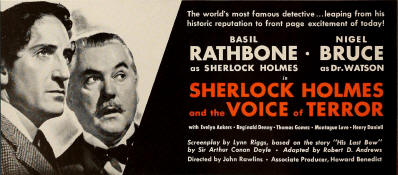Sherlock Holmes and
|
|||||||||||||||||||||||||||||||||||||||||||||||||||||||||||||||||||||||||||||||||||||||||||||||||||||||||||||||||||||||||||||||||||
 Discussing the Voice of Terror with the Inner Council |
 Holmes: "When we go out that door, a young lady will greet us." |
Meanwhile, Sherlock Holmes reports to the Inner Council. From analyzing minute differences between recorded and live broadcasts of Beethoven's Fifth Symphony, Holmes has deduced that the Voice of Terror is actually a recording. The man behind the Voice of Terror is in England. The recordings are flown to Germany and then broadcast from there. Holmes explains that the Voice of Terror broadcasts are carefully timed to air moments after the disasters occur.
The Air Ministry informed Holmes that at regular intervals six Nazi planes fly over and drop their cargo on non-military targets. A single plane breaks formation. Holmes deduces that the lone plane picks up secret military plans and the Voice of Terror's recorded message, and flies them to Germany. Because of the type of secret information being leaked, Holmes deduces that there is a traitor in the Inner Council, and that the Council members are in grave danger.
Having discovered that "Christopher" refers to the old, abandoned Christopher Docks, Holmes and Watson, followed by Lloyd (Henry Daniell), go there to investigate. They come face-to-face with Meade and his Nazi henchmen, who hold them at gunpoint. Holmes didn't come alone, though, and Kitty's friends from Limehouse appear and disarm the Nazis. Meade manages to escape through a trap door.
Holmes engages Kitty to get close to Meade and find out what he's planning. Kitty informs Holmes that she heard Meade say he would take care of that "Seven Oaks" matter. Knowing that Sir Evan Barham has a home in Seven Oaks, Holmes and Watson immediately drive there to warn Sir Evan.
Sherlock
Holmes and the Voice of Terror
—Motion Picture Reviews, November 1942 |
Holmes catches up with Sir Evan as he is on his rounds as Air Warden. They hear air raid sirens and spot one Nazi plan. As it comes in for a landing, they see Meade run to the plane. Meade puts something on the plane and runs off. Sir Evan shoots at him, but misses, and he's annoyed with Holmes for not helping him.
Back at the ministry, the Council is listening to the Voice of Terror announcing that the Nazis will strike somewhere on the coast tomorrow morning. The council thinks it must be the northern coast, and are prepared to deploy troops there. But when Holmes learns that Meade and Kitty have driven to the southern coast, he convinces the council that the attack will take place on the southern coast. The threat against England's northern coast was a ruse to leave the south undefended.
Holmes, Watson, the Council members and British officers surprise and capture the small group of Nazis who were waiting in a bombed-out church to receive an invasion army proceeding across the channel. When he realizes he's been betrayed, Meade shoots Kitty. She dies a heroine.
Holmes has deduced that the Voice of Terror is a member of the inner council; no one outside of the inner council should have known that Holmes was on the case, and yet, German agents knew. He stuns everyone present when he announces that the Voice of Terror is none other than Sir Evan Barham. Barham was actually Heinrich von Bork, a German who resembled the real Sir Evan. With some plastic surgery von Bork was able to fool everyone who knew Barham, even his old school chum Watson. At Seven Oaks, when it appeared that Sir Evan was shooting at the German plane, he was actually warning it away.
 Holmes hears a sound at the door. |
 As Gavin dies, he says, "Christopher!" |
Sherlock Holmes and the Voice of Terror was inspired by the Conan Doyle story "His Last Bow," a story in which Sherlock Holmes comes out of his bee-keeping retirement to help trap a German spy in England, circa 1914, or a little earlier. The German spy's name was Von Bork—the same name as the German spy masquerading as an Englishman in The Voice of Terror. Otherwise the stories are completely different. The speech Holmes gives at the end of the film (quoted below) is nearly word for word the same as the end of "His Last Bow." The inclusion of this speech was a concession to the estate of Sir Arthur Conan Doyle, who insisted that the film must correspond, at least in part, with the original story.
Watson: "It's a lovely morning, Holmes."
Holmes: "There's an East wind coming, Watson."
Watson: "I don't think so. Looks like another warm day."
Holmes: "Good old Watson. You are the one fixed point in a changing age. But there's
an East wind coming all the same, such a wind as never blew on England yet. It will be
cold and bitter, Watson, and a good many of us may wither before its blast. But it's God's
own wind none the less. And a greener, better, stronger land will be in the sunshine when
the storm is cleared."
The plot idea of a German spy impersonating an English aristocrat to whom he bears a resemblance is taken from a 1920 novel, The Great Impersonation, by E. Phillips Oppenheim. Set during the First World War, the story has Baron von Ragastein returning to England from a sojourn in East Africa as Sir Everard Dominey, his lookalike. From his position in English society, "Dominey" is able to supply the Germans with information.
An interesting fact that modern viewers may not be aware of is that there really was a "Voice of Terror" in London during the Second World War, though he didn't use that name. William Joyce was one of several broadcasters who was known by the name "Lord Haw Haw." A former member of the British Union of Fascists, Joyce left England in 1939. He became famous for his wartime broadcasts to England, alarming listeners with threats of invasion and anti-British propaganda. The British public who watched Sherlock Holmes and the Voice of Terror in the theaters in 1943* were certainly familiar with Lord Haw Haw's broadcasts.
*Although the film was released in the USA in September 1942, it wasn't released in Britain until October 1943. The reason for this delay is unclear. In her book England's Secret Weapon, Amanda Field speculates, "This may have been because of censorship problems: the plot concludes with Holmes unmasking the head of British intelligence as a Nazi spy" (p. 120). One can't help but wonder what had changed by October 1943 to suddenly allow releasing the film.
 As they leave their apartment, Watson cautions Holmes against wearing the deerstalker, saying, "You promised!" |
 Watson deduces, "Bullet wound." |
Sherlock Holmes and the Voice of Terror (working title: Sherlock Holmes Saves London) contains one of my favorite lines from all the Holmes films. Evan Barham, of the Inner Council, shows Holmes and Watson his bandaged hand and explains that someone shot him. As Watson examines the hand, Holmes asks, "What do you make of it, Watson?" Watson replies, "Bullet wound."
Sherlock Holmes and the Voice of Terror is not the best of the Holmes films, but a very good one and very entertaining, nevertheless. Holmes shows off some brilliant deductions about the council members upon meeting them. The cinematography has a film noir feel to it, as most scenes are at night or in subdued light. The Voice of Terror is the only one of the Universal series not directed by Roy William Neill.
Observant film buffs will notice that the train wreck seen at the beginning of The Voice of Terror was footage used in Universal's 1933 film, The Invisible Man.
"The same old Sherlock—and the same old Basil Rathbone, too—only this time with a sort of wind-blown hair-do and markedly without deerstalker cap, is again prowling around in foggy London and the sinister cellars of Limehouse, ferreting out the Nazi agents who not only commit sabotage all over England but have the effrontery to proclaim their acts on the radio." —Bosley Crowther, New York Times, September 19, 1942
 Holmes asks Kitty, "Do you know what 'Christopher' means?" |
 The Inner Council listens to another Voice of Terror broadcast. |
"Sherlock Holmes, the screen's leading anachronism, is currently combating the Nazis and winning handily. 'Sherlock Holmes and the Voice of Terror,' his latest vehicle, is supposed to be based on 'His Last Bow,' but you will notice deviations to the approximate number of three hundred. Holmes and Watson are portrayed by Basil Rathbone and Nigel Bruce, whom a rising generation probably looks on by now as the original models." —David Lardner, The New Yorker, October 3, 1942
"The move from one studio to another [20th Century Fox to Universal] had not changed the brilliance of Rathbone's performance." —David Stuart Davies, Starring Sherlock Holmes, (Titan Books, 2001)
"Rathbone ... and Bruce were at their best in the roles, which they were, by now, quite familiar with." —Michael Druxman, Basil Rathbone: His Life and His Films (A.S. Barnes, 1975)
 Watching London's East End burn |
 Holmes explains that the Voice of Terror broadcasts are recorded in England and flown to Germany. |
See more photos and reviews of The Voice of Terror on page 2.
See Posters, Lobby Cards and Promo Photos on page 3.
..
|
|||||||||||||||||||||||||||||||||||||||||||||||||||||||||||||||||||||||||||||||||||||||||||||||||||||||||||||||
|
Sherlock Holmes and the Voice of Terror is available on DVD
|













